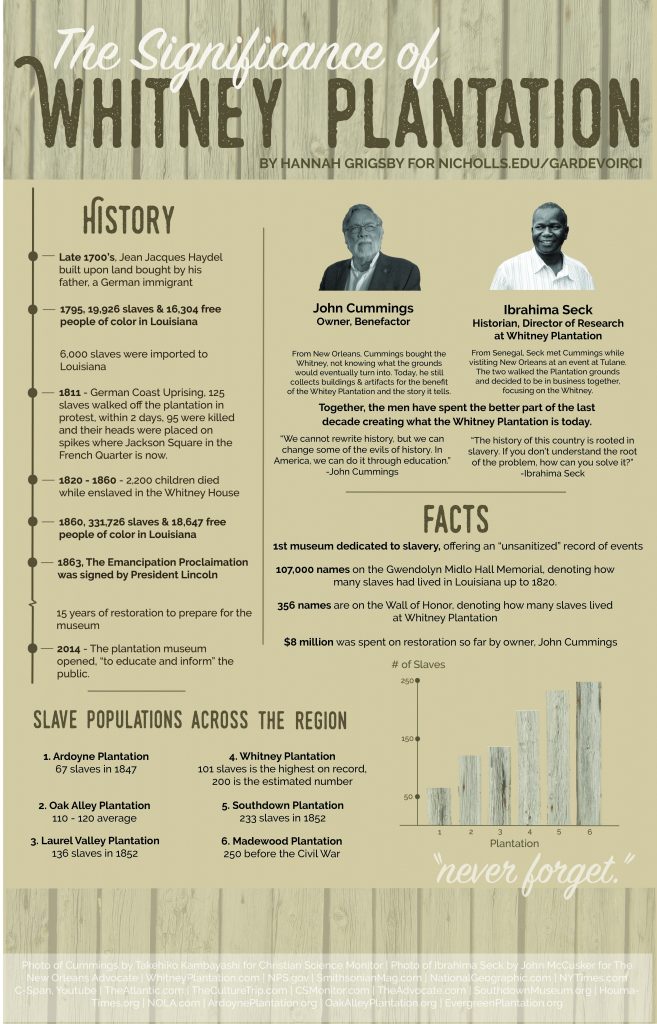by Trevor Johnson, features editor
Southern plantations have long been tourist stops for curious travelers from around the world — most offering wedding services, detailed accounts of wealthy slaveholders, and cheap memorabilia. However, Whitney Plantation, located in Wallace, LA, breaks the mold by giving an unflinching look into the lives of its former slaves.
“Our mission is to tell the story of the enslaved people,” says Joy Banner, the director of communications at Whitney Plantation. “Other plantations talk about slavery, but we are the only plantation museum with an almost exclusive focus on slavery.”
Whitney Plantation stands on a grassy plot of land near a levee of the winding Mississippi River. Visitors can walk the grounds through a guided tour, Whitney’s main attraction. The tour, which has a variety of admission prices, lasts about 90 minutes, and gives visitors the opportunity to explore slave quarters, a church, a historical blacksmith’s workshop, and more. The tour also includes visiting a memorial to the slaves who worked the plantation.
“In addition to telling the history of slavery, Whitney Plantation serves as a memorial to the slaves who worked here, which can be a painful subject,” says Sydnee Council, a tour guide at Whitney. “Some people cry. Some people get angry.”
Statues of enslaved children, creatively depicted as they would have appeared on the day of the plantation’s emancipation, dot the grounds in various locations, such as sitting in church pews, or perched solemnly on the porch of a slave cabin, their dangling legs forever captured mid-swing. Over the course of the tour, their unblinking gaze forces visitors to confront one of America’s greatest wounds.
After the tour, visitors may keep their tour pass. Each tour pass contains a unique account from one of the slaves who worked the plantation. Whitney also offers a free exhibit, which details the general history of slavery in America, inside its main building.
Although plantation tourism may seem like a modern affair, plantations have received tourists since the 1800s.
“Plantations became a tourist destination as early as the 1830s,” says Stuart Tully, a history professor at Nicholls State University. “There were grand tours going around the South, with visitors from Europe and elsewhere. Even when they were working plantations, there was a small element of tourism.”
According to Tully, plantation tourism dipped during the Civil War, and wouldn’t fully return until around the 1930s. The version that returned, with the veneration and reverence of “Southern heritage,” is the version that is most recognizable today.
“It came back because of financial necessity, coupled with the lost cause mythos,” says Tully. “The idea that you’re buying into this idea of the Antebellum South, with Spanish moss, and fans, and ladies. That’s when you really start getting into the imagined past. They saw imagining the past as profitable.”
Whitney Plantation aims to dispel the “imagined past” of Southern plantation culture, most commonly depicted in the film Gone with the Wind. Although the plantation has stood since 1752, it was bought by John Cummings in 1999, who, according to Banner, began transforming the plantation into the institution it is today.
When Cummings bought the plantation, he also received several volumes of research. That research, combined with his reading of slave narratives, inspired Cummings to craft an educational experience focusing on the lives of slaves. After about 15 years of restoration, Whitney Plantation opened its doors to the public as an informative journey through the lives of America’s most forgotten voices.
“People want nostalgia,” says Banner. “We don’t do nostalgia at Whitney Plantation. That’s a fantasy. That’s a fairy tale.”
For more details about Whitney Plantation and their tour, visit https://www.whitneyplantation.com/.

